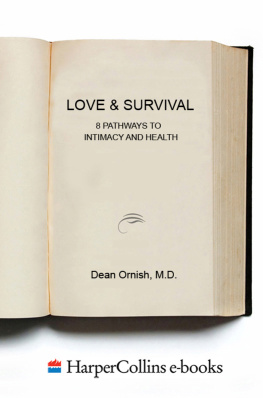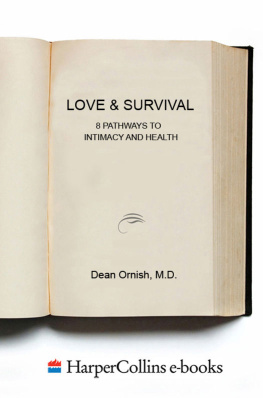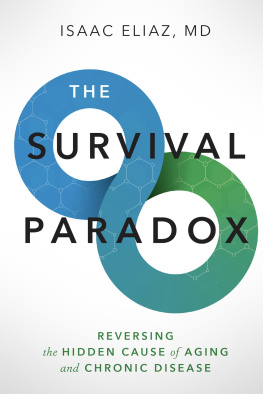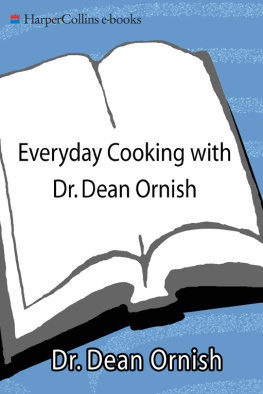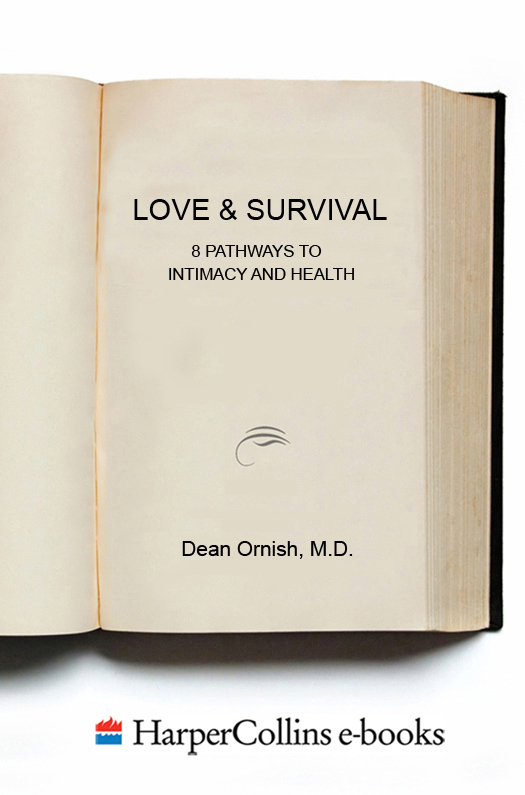For Molly
If they can get you to ask the wrong questions, then they dont have to worry about the answers.
Thomas Pynchon, Gravitys Rainbow
Think different.
Apple Computer
Contents
Guide
It has been almost a year since the publication of Love and Survival. Much has happened in my life since then.
During the past year I have received thousands of letters from people who told me how meaningful and even healing it was for them to learn that they were not alone in their feelings. Many of these letters were from physicians. They often expressed their desire to reclaim the soul of medicine, to be healers and not merely technicians.
I learned from these letters that I had given voice to the suffering that so many people have been experiencing, both within and outside the medical profession. My willingness to talk openly made it easier for many others to do so. In some ways, this book has served the same function as a stable community, an extended family, or a group support session: a place to realize that youre not alone and that your private feelings are often shared by others.
One of the most painful parts about feeling isolated and depressed is that it may seem as if youre the only one feeling this way. Everyone else appears to have it together and to be doing just finebecause if you dont have anyone with whom you talk openly, you dont have the opportunity to experience how much suffering is all around you. There is a conspiracy of silence. Suffering can lead to compassion and transformation or just as easily to cynicism and despair.
Giving voice to suffering often makes it easier for others to experience and express their pain more fully and then let go of it. Community and intimacyin any formhelp us to bear suffering. When we realize that we are not alone in our distress, the pain becomes much more bearable. We can use the pain as a catalyst to transform suffering into joy, loneliness into intimacy. Paradoxically, in the process of sharing loneliness, we experience that we are not alone.
Writing chapter 3 of this book was especially hard, since I revealed a lot of my personal struggles and difficulties in learning how to be in an intimate relationship. I wanted to share part of my journey in hopes that it would be helpful, but it was a little scary to be that open and self-disclosing. I was also concerned that my willingness to describe my shortcomings might compromise my credibility, at least in some peoples eyes.
Instead, I was reminded from the letters I receivedyet againthat the very actions I thought were the most likely to cause me to lose credibility and support from others were the ones that were the most meaningful to many people. On the other hand, I quoted many studies in chapter 2 in order to provide credibility for the importance of love and intimacy, but some people thought I had included too many. They wanted to get right to the chapters that described how what I am learning on my journey for love and intimacy could help them in their own process. They wanted a trusted field guide who could help them navigate the eight pathways to intimacy described in chapter 4.
On June 7, 1998, Molly and I were married. Although we had been in a committed relationship for some time, I was surprised that being married really did make a profound difference.
It took a whileseveral months, actuallybefore it really sank in. Were married, we would say to each other incredulously from time to time. We are husband and wife. The joy and ecstasy we experience in this relationship exceed anything I have ever dreamed of. Day by day, I am learning to trust, to grow, to give and receive love more fully. In chapter 3 of this book I wrote that there is no point in taking a chance to open your heart to another person and risk pain unless the ecstasy is worth it.
I can now tell you even more fully from my own experience that its worth it. Its worth all the pain and suffering that it took to get to this place. And this experience of intimacy is available to anyone who has the courage to open his or her heart to another and to put into practice the pathways to intimacy I describe in this book. Romantic intimacy is only one form and expression of intimacy.
Last month the Journal of the American Medical Association published the five-year results from the Lifestyle Heart Trial. In brief, my colleagues and I found increased reversal of severe coronary heart disease after five years than after one year in the patients who followed my program. (Not every patient and not every artery showed improvement, but most did.) In contrast, we found that the comparison group of patients who made more moderate changes in diet (and who did not receive support groups, medication, or other training in love and intimacy) showed increased worsening of their heart disease after five years than after one year. Also, there were more than twice as many cardiac events (including deaths, heart attacks, bypass operations, and angioplasties) in that group than in the experimental group of patients who followed my program.
Two months ago the American Journal of Cardiology published results of the Multicenter Lifestyle Demonstration Project from sites around the country that are offering my program. We found that almost 80 percent of patients who were eligible for coronary bypass surgery or angioplasty were safely able to avoid these procedures by making comprehensive lifestyle changes instead. By avoiding surgery, almost $30,000 in medical expenses was saved per patient.
Having seen what a powerful difference changes in diet, love, and intimacy can make, I hope that these studies will help to increase insurance reimbursement of my program to make it more widely available to those who may benefit from it. Talking with an insurance company about the health benefits of love and intimacy is less persuasive than presenting data showing an immediate savings of almost $30,000 per patient. Reimbursing my program for reversing physical heart disease also makes it possible to train people to open their hearts in emotional, psychosocial, and spiritual ways as well.
Awareness is the first step in healing, both individually and socially. Part of the value of science is to increase awareness that the choices we make each day matter. Not just a little but a lot, and not just to the quality of life but also the quantity of lifeto our survival.
Just as individual suffering can be a catalyst for changing your life, I hope the experience of suffering that is so widespread in our society can be a catalyst for social and political changes. By addressing the more fundamental causes of suffering and illness rather than bypassing them literally or figuratively, my colleagues and I are demonstrating that a new model of medicine that is more caring and compassionate is also more cost-effective and competent.
The desire for love and intimacy is a basic human need, as fundamental as eating, breathing, or sleepingand the consequences of ignoring that need are just as dire. You are likely to live longer if you put into practice what I describe in this book. However, the mortality rate is still one hundred percent, one per person. When we are able to open our hearts on all levelsanatomically, emotionally, and spirituallywe can live every moment in fullness. And when the time comes to die, we will know that we have fully lived.
Dean Ornish, M.D.
Sausalito, California
January 1999


